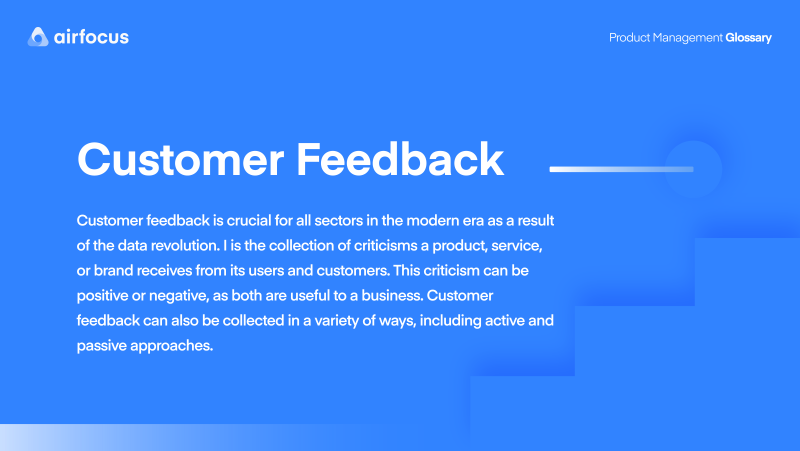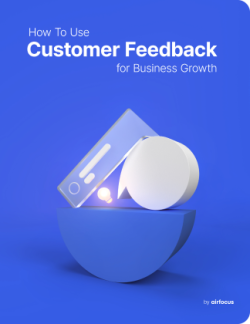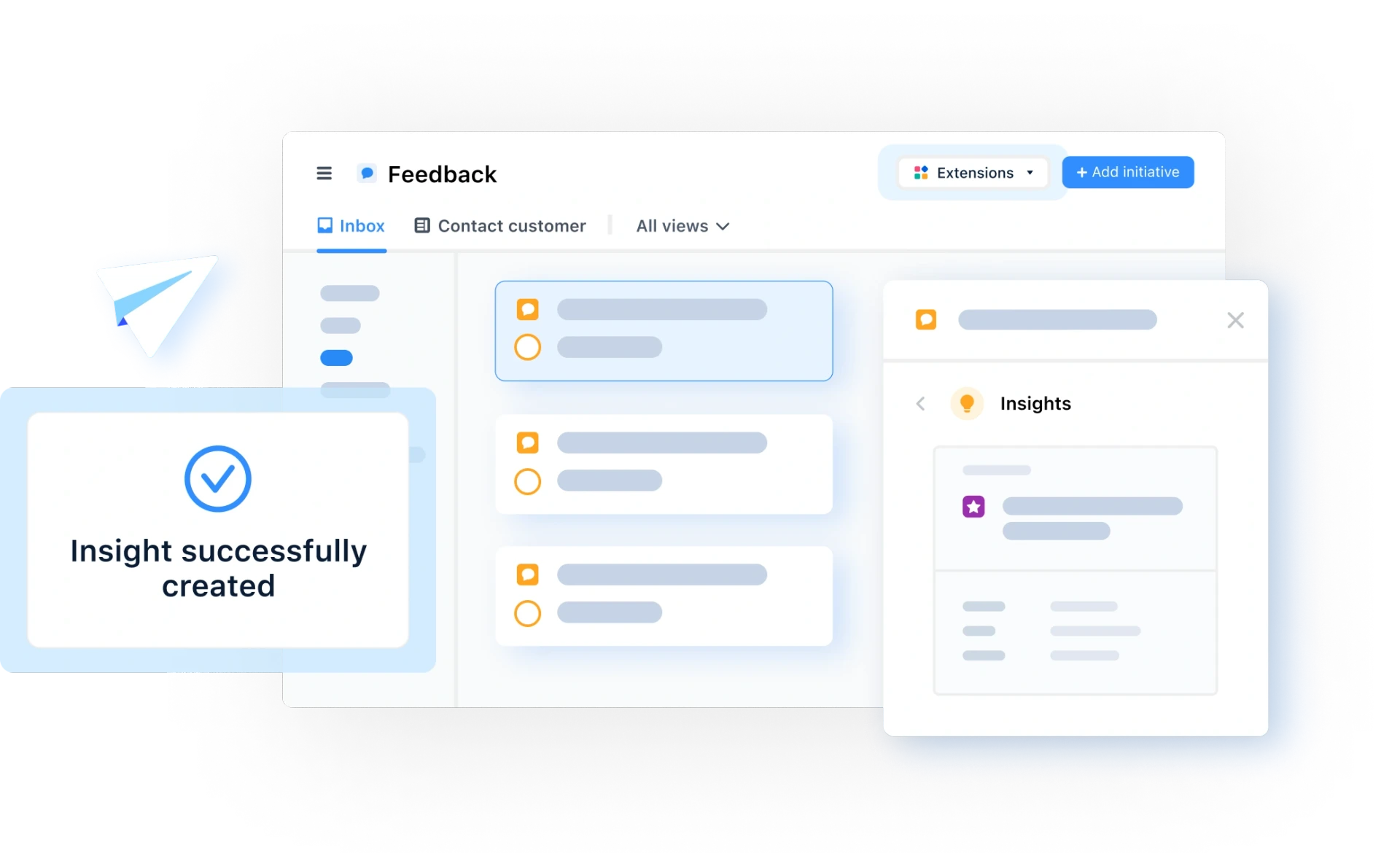Customer Feedback
What is good customer feedback?
What is customer feedback?
Customer Feedback Definition - Customer feedback is the collection of criticisms a product, service, or brand receives from its users and customers. This criticism can be positive or negative, as both are useful to a business. Customer feedback can also be collected in a variety of ways, including active and passive approaches.
"Good" customer feedback is the feedback that your business can implement into the product development process. For example, a user may tell you they prefer the color green over yellow, but that might not be something you can incorporate into future iterations of your product. Additionally, feedback that you are unable to implement, either because of logistics or resources, is also not necessarily "good" feedback.
Download Now: Get our 5-minute guide on Why Insights Are Essential and How to Source Them To ensure that you're getting usable customer feedback, you can take an active approach to collect that feedback.
Passive methods for collecting feedback involve scraping feedback that customers are leaving in comments sections, product reviews, and forums. Though organic, this feedback is usually unstructured and not fixed to any of your goals.
Active feedback, on the other hand, is the feedback you request from your customers and users. For instance, if you send out an email to your customers asking for feedback, that's an active approach. Active strategies are useful because you can be specific about what elements of your service you need feedback on.
Why is customer feedback important?
Customer feedback is crucial for all sectors in 2021 as a result of the data revolution. Nearly every company has access to a plethora of data from their customers and users, and customers now expect businesses to be using that data. That means personalizing experiences, meeting expectations, and tailoring your service with precision.
The software industry, though, has the most to gain by investing in customer feedback. That's because this industry relies on iterative product development. Unlike a physical product, a digital product can and should be updating and improving with regularity.
And how do you know which improvements to make? By incorporating customer feedback into your development process.
How can I improve my strategy and process?
As mentioned, the best way to improve your customer feedback strategy and process is to take an active approach. Passive feedback, like unprompted product reviews, are useful in their own right. But to truly capitalize on feedback, an active approach is required.
The first thing to do when creating an active approach to collecting feedback is setting goals. Determine which aspects of your product you want to improve and then carefully craft questions that will garner the feedback you're looking for.
Second, find the best way to reach your target audience. That could be pre-purchase customers, post-purchase customers, customers over or under a certain age, all of your customers, etc. Decide on a demographic and make sure they see your request for feedback.
Third, make it easy! Customers who respond to a survey, poll, or questionnaire are spending their time doing so. Make it enticing, fast, and possibly even rewarding.
What are the types of customer feedback and examples?
Generally speaking, there are three types of customer feedback:
Product feedback. Product feedback is a comment or criticism of your product itself. Examples include how easy it is to use, features your users wish it had, and features that don't work as expected.
Customer service feedback. Customer service feedback is a comment or criticism of your customer support service. Examples of this include direct interactions with your customer support team as well as the FAQs and knowledge articles on your site.
Marketing and sales feedback. This feedback is a comment or criticism on your marketing materials. An example of this is making sure that marketing materials are setting appropriate expectations.
Use customer segmentation for better customer feedback
Who should you get feedback from?
You can gather feedback from all channels and customers, but targeting specific customers is often better. Say you’re looking to improve a feature. You would narrow your feedback scope to those who use that feature. This is where customer segmentation comes in.
Customer segmentation categorizes your users to help personalize your marketing, service, sales, and development efforts. Segmenting your users can help uncover specific insights to influence specific decisions, increasing customer satisfaction and brand loyalty.
You can segment using different criteria like:
Demographics - Such as age or location.
Behavior - How do they use your product? Which features do they use most? Etc.
Pain points - What issues have users reported?
How they found your product - For help with marketing efforts.
How often they use your product - Low usage may mean users need new features.
How they communicate with you - To help improve your customer engagement efforts
Once you have decided which criteria to segment your users by, you can use a range of tools that feedback into airfocus Insights to identify which users belong to which segment.
Collecting feedback from different customer segments
Different customer segments require different approaches when it comes to gathering feedback. Feedback will come from certain channels more than others, allowing you to narrow your scope and improve focus.
It’s worth noting that you should be using a mixture of feedback channels, even when targeting a specific customer segment. While your efforts are targeted, not everyone within a segment will use the same feedback channel.
Use different methods like:
Feature requests
Feedback forms
Email
Social media
Reviews
Support tickets
As with any other kind of feedback collection, feedback from each customer segment will ultimately come from various channels. Thankfully, with airfocus Insights and airfocus Portal, collecting feedback from any customer segment is easy, and you can gather all your information in one place. This will help you prioritize feedback so you can work on the most important issues. You can even use our AI Assist to help you sort feedback and analyze sentiment.
The key thing to remember with customer segmentation is that you must have a strong understanding of what each segment represents. It’s not just a category to use for organization — it’s an insight into each user that will help guide your future efforts.
Tips for modern customer feedback tools
When looking for the right customer feedback tool and ensuring that it is providing you with the value it should, you want to once again start with your goals. Determine what kind of feedback you want and who you want it from. Then, look for the feedback collection tool that matches that goal.
Another tip to keep in mind is that simple feedback solutions work best. Don't over-engineer your approach! Target your desired audience effectively, ask direct questions, and make it easy to create and submit feedback to you.
Here is a list of 13 best customer feedback tools compared to help you make an informed choice.
How can customer feedback software help?
Customer feedback software is useful in that it eases the feedback process for you and your users. Feedback software is a pre-built solution, saving you time. And these pre-built solutions are generally well optimized, making it easy for your customers to use them.
The most common customer feedback questions and loops
What features of our product do you like/dislike the most?
How could our product work better for you?
If you could add/remove/change one feature of our product, what would it be?

General FAQ

Glossary categories
All product feedback in one place

Experience the new way of doing product management








